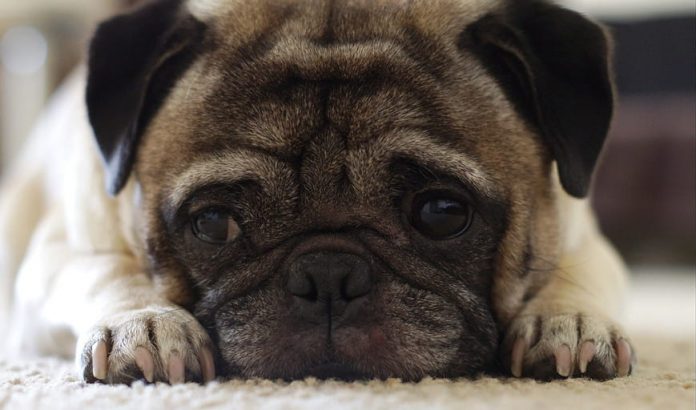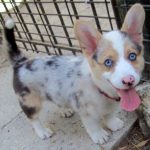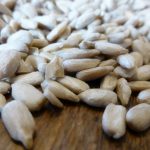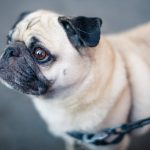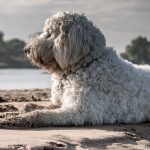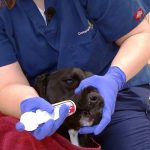Are you planning to get a pug? If you want to have a long-living dog, you will be glad to know that pugs are among the breeds with the longest life expectancy. Read on to learn more about their average lifespan.
What Is the Life Expectancy of Pugs?
Pugs can live up to 12-15 years. The male pugs have an average lifespan of 12.8 years while the female ones have an average of 13.2 years.
Can pugs live more than 15 years? Yes, it is possible for pugs to livelonger depending on how you take care of them. There are pugs who live 16 years and more. One of them is King Tug the Pug, an 18-year-old pug in America.
Do note that your pug’s lifespan depends on a number of factors. In addition to breed, a pug’s health is another factor that determines his longevity. The healthier the pugs are, the longer they will live.
That leads us to our next concern. Are pugs generally healthy or do they require frequent trips to the vet because they are prone to a number of diseases?
The Common Health Issues Linked To Pugs
Pugs are among the dog breeds with the best social traits. They are the ideal breed to have if you want a happy, charming, and affectionate buddy. Their fun-loving nature is the reason why they are often hard to resist.
However, you have to be prepared because they are not the easiest breed to take care of. Pugs are predisposed to particular diseases mainly because of their appearances.
They are designed to have a smaller skull and a flattened nose, which can have an effect on their well-being. Here are some of thecommon health problemspugs have:
1.Reverse sneezing – your pug might look like he is choking when he does his thing but there’s no reason to panic because it’s just a spasm that normally happens to breeds with flat faces and short noses. It’s possible that your pug was irritated by dust, pollen, and perfumes. Most of the time, it’s just because of their excitement from play or exercise.
2.Eye injuries – because their snouts are not long enough, not to mention that they don’t have prominent skeletal brow ridges, they sometimes suffer from scratched corneas. Pugs are vulnerable to eye inflammations because of the elements that may go into their eyes. This can result in swelling, redness, and dull eyes. Some pugs can suffer from entropion. This is hereditary and results in their eyelashes growing inward and scratching the eye.
3.Breathing problems – pugs may have difficulty breathing because of their compact passageways. Places with high temperatures are not suitable for pugs because of their breathing troubles. Some pugs are also born with stenotic nares, a problem that often occurs in short-nosed dogs.
4.Hip dysplasia – a study led by the Orthopedic Foundation for Animals revealed that around 64% of pugs were affected by hip dysplasia. This is a genetic condition but symptoms usually occur when pugs are around one year old. Some pugs can show signs as early as from 4 months of age. If your pup looks like he is in pain while walking or running and if his hind leg is stiff, it’s possible that he has hip dysplasia.
5.Keratoconjunctivitis Sicca – also known as the dry eye syndrome, this condition happens when there is a defect of the aqueous tear film over the surface of your pug’s eye. It manifests by uncontrolled blinking, pus or mucus coming from the eye, blood vessels growing rapidly throughout the dog’s eye, and enlarged conjunctival blood vessels.
Aside from these, there is a specific disease that only targets pugs. It’s called Pug Dog Encephalitis or PDE. Experts still do not know the exact cause of this condition.
It is not like any other types of encephalitis that are caused by infections. Still, vets believe that PDE is hereditary as it occurs in closely related pugs. Since it is thought to be genetic, vets go against breeding pugs diagnosed with his type of encephalitis.
A pug with this condition would show neurological symptoms, such as seizures, disorientation, and loss of coordination. Pugs also show changes in their behavior often manifested in the lack of energy or appetite.
There are various ways to carry out supportive treatment for a dog with PDE. Pugs experiencing seizures in the early stages are often given anti-inflammatory drugs to reduce the inflammation of the brain. Seizure activities can be lessened by giving dogs Valium, which is a drug also used for treating anxiety and other conditions.
How to Increase Your Pug’s Life Expectancy
The quality of care you provide your dog will keep him healthy and happy, which are the keys to him leading a long life. You will not have a hard time making your pug happy as long as you keep him company and you give him lots of affection.
Pugs are also dubbed as “loving clowns” that can be their owner’s loyal companion. They are suitable for families even for those with small children. Pugs are not hard at all to please. Take note of the proper ways of caring for pugs, all listed below.
Keep your Pug happy and stress-free.
Chronic stress can negatively affect your pug’s immune system. Keep him happy by spending quality time with him. It can be as simple as giving him a bath or playing with him.
Pugs can be very distressed when left alone. They tend to be super-needy and would feel really bad if you leave them for hours. When you don’t have a choice but to leave your pug home alone, consider putting him in an indoor canine playpen rather than a crate.
You could play some music so your pug will not feel alone. Chew toys and treat-release will also keep him occupied. During your free time, plan visits to the local dog park to combat his loneliness.
Get rid of toxins and dangers.
Their environment plays a big role in theoverall being of pugs. Keep poisonous chemicals such as pesticides, house cleaning agents, and herbicides away from them.
As with any dog breed, pugs have the tendency to eat almost anything: doughnuts, pasta, candies, or just anything that they can chew and swallow! Make sure to not leave any cleaning agent or harmful elements around when you have a pug.
Some pugs even ingest stuff they are not supposed to eat. This includes things like candy wrappers and plastic. Make sure that you keep those things out of your pug’s reach.
Clean your Pug’s wrinkles regularly.
Their wrinkles can be a place where bacteria develop easily. If not cleaned, this will cause skin irritation and infection. Use a cotton swab dipped in warm water to clean your pet’s facial folds. You can also use unscented baby wipes. Do it at least once a week.
For messy pugs, you can clean them using a solution of white vinegar, rubbing alcohol, and witch hazel. The amount is 5 tablespoons each. You can also add 10 drops of tea tree oil to this homemade solution.
If your pug’s nose smells unpleasant, it’s best to have him checked by a canine dermatologist. Dogs with such problem are often prescribed Mometamax, an otic suspension used for treating bacterial infections and inflammations in dogs.
Pugs with deep wrinkles can be sprinkled with a bit of Neo-predef powder. If you have a pug that needs a thorough cleaning, ask your vet about this kind of powder for proper usage.
Take Pug for a short walk every day.
Like most dog breeds, dogs are social creatures that enjoy meeting new people and pets. They love spending time outside. However, pugs tend to get tired quickly because of their breathing problems.
It’s true that you can’t take your pugs outside for a long time. They are lap dogs originally bred for royals. But that does not mean they can be couch potatoes forever! Contrary to the myth, pugs are not very lazy. The young ones can be a bit hyper too, like any puppy from other dog breeds.
Pugs don’t have to exercise as much as other breeds because they get tired easily. When you take your pug for a walk, use a body harness rather than a neck collar. This allows your pug to breathe easier. If you’re not at home most of the time, consider getting a dog walker who could give your pet his regular playtime and walks.
Provide your pug with a good nutrition.
Adult pugs need 40 calories per pound of body weight. On average, pounds weigh between 14 and 18 pounds. That means pugs should consume roughly 560-720 calories per day.
Pugs ages 6 months and above should be fed twice a day. The amount of food for adolescent pugs, which are aged 6 months to one year, is ¾ of a cup per feeding. Active adult dogs can be given half a cup of food per feeding while senior ones can get only 1/3 cup of food every feeding.
Young pugs usually need to consume more food. Pug puppies aged 3 to 6 months should be fed three times a day and the amount should be 1/3 of a cup per feeding. They need to eat more because they are more active compared to adult and senior dogs.
Poor nourishment can cause serious health issues and eventually a reduced lifespan in dogs. Pugs should be fed a high-quality diet twice a day, depending on their activity level. Be careful about what you feed your pug. Although most pugs are not picky eaters, they are prone to food allergies.
Pugs with food allergies are more susceptible to having pyoderma and ear infections. Some of them develop hypersensitivity to grains, beef, and dairy. If you already have a pug that has a history of food allergies, ask your vet about changing his diet.
If your pug does not have any food allergies, you can give him a balanced proportion of meat, fruits, and vegetables. Most pugs enjoy a serving of carrots, regardless if they are raw or cooked.
They also like fruits such as berries, banana, and watermelon. When it comes to savory treats, pugs cannot help but delight in chicken with rice. You can also give pugs veggies like kale, spinach, and pumpkin.
Give your pug fresh, clean water daily.
Hydration is very important for pugs since they are prone to dehydration and skin dryness. As the rule of thumb, pugs need to consume a cup for every 5 pounds of body weight. An adult pug weighing around 20 pounds needs to consume around 4 cups or 30 oz. of water per day.
If you are not always around, make sure he has access to fresh and clean water at all times. Before leaving the house, make sure that your dog’s water bowl is refilled with fresh water. As much as keeping the water fresh and clean, his drinking bowl should also be cleaned with hot water and dish soap before refilling it.
Conclusion
Pugs often live long enough in spite of their vulnerability to certain diseases. Genetics play a critical role in this matter, but through nutrition, safe environment, exercise, and proper care, dog owners can help their pugs live more.
Apparently, there are so many things you need to know before getting a pug. One of them is the fact that they can be high-maintenance because of their many health issues. In spite of this, it is worth it to get a pug because they are among the best lapdogs. They are lovable and they enjoy companionship.






